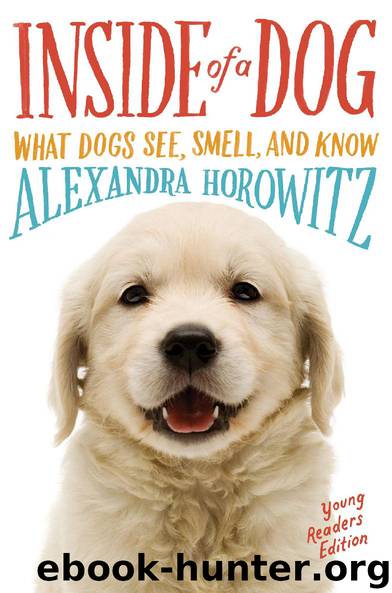Inside of a Dog -- Young Readers Edition by Alexandra Horowitz

Author:Alexandra Horowitz
Language: eng
Format: epub
Publisher: Simon & Schuster Books for Young Readers
Maybe this is why dogs don’t seem to think carefully about which screen the toy is behind. Or maybe there’s another reason.
Here’s another experiment to consider. Show your dog a ball, and then hide it from him under one of two cups. Make sure your dog doesn’t see which cup the ball went under. If your dog can’t smell the ball, and if he’s got no clues about which cup is hiding it, he’ll look under either cup at random. A logical approach. We’d do the same if we had no clues.
But suppose you give your dog a clue. Let him peek under the cup with the ball. Now he knows where it is, and once he’s allowed to search, he’ll go straight for the right cup. That’s not surprising.
But suppose you give your dog a different kind of clue. Suppose you let him peek under the wrong cup, the cup where the ball isn’t. Then let him try to find the ball. Will he go for the right cup? Will he figure out that if the ball isn’t under the cup you showed him, it must be under the other one?
He won’t. He’ll go right for the empty cup first.
Does that mean dogs are, well, a bit dim?
Or does it mean dogs are focused not on cups and balls, or toys and screens, but on something else? On people?
Dogs, as we have seen, pay a lot of attention to people. They are good at paying attention to people. When they are given a problem to solve, dogs cleverly look to us. As far as dogs are concerned, the things that human beings do are important, full of information. (One reason for this, of course, is that our actions often lead to dogs getting food.)
If a person flips over a cup, a dog will be interested in that cup (whether it has a ball under it or not). If an experimenter ducks behind screen #2, a dog will be interested in that screen. The dog’s attention goes where the human’s attention goes. These experiments don’t necessarily prove that dogs are not smart. They prove that dogs have learned to keep their eyes, and their attention, on human beings.
If the researcher keeps this truth about dogs in mind, dogs do much better on the tests. If you show your dog an empty cup, but then put your hands on the other cup as well, your dog is more likely to figure the problem out. He’ll realize that the ball is not under the empty cup, and he’ll search for it under the right one.
In one experiment, wolves and dogs were tested to see which did better at getting food out of a locked box. Wolves seemed to beat the dogs at this task. They would keep at it until they got their mouths on the food. Maybe they figured out how to open the box, or maybe they just kept trying and trying until something worked.
Dogs, on the other hand, would try for a while.
Download
This site does not store any files on its server. We only index and link to content provided by other sites. Please contact the content providers to delete copyright contents if any and email us, we'll remove relevant links or contents immediately.
| Breeds | Care & Health |
| Training |
Finding Gobi by Dion Leonard(2263)
Grumpy Cat by Grumpy Cat(2130)
The Silkworm by Robert Galbraith(2009)
A New Earth: Awakening to Your Life's Purpose by Eckhart Tolle(1978)
End of Days by Sylvia Browne(1828)
Tippi by Tippi Hedren(1769)
Total Cat Mojo by Jackson Galaxy(1689)
Backyard Chickens Beyond the Basics by Pam Freeman(1619)
The Animals Among Us by John Bradshaw(1510)
The Ultimate Pet Health Guide by Gary Richter(1433)
Vet in Harness by James Herriot(1388)
Cesar's Way by Cesar Millan(1368)
Dog Years by Mark Doty(1365)
Doggy Desserts: 125 Homemade Treats for Happy, Healthy Dogs by Cheryl Gianfrancesco(1361)
All Things Bright and Beautiful by James Herriot(1308)
Chicken Soup for the Ocean Lover's Soul by Jack Canfield(1295)
Walking with Peety by Eric O'Grey(1287)
Dog Training 101 by Kyra Sundance(1265)
Encyclopedia of Dog Breeds by D. Caroline Coile Ph.D(1182)
